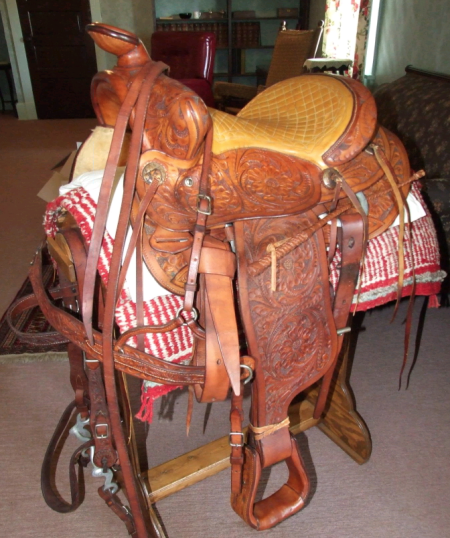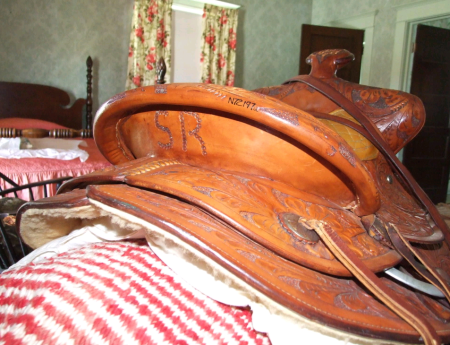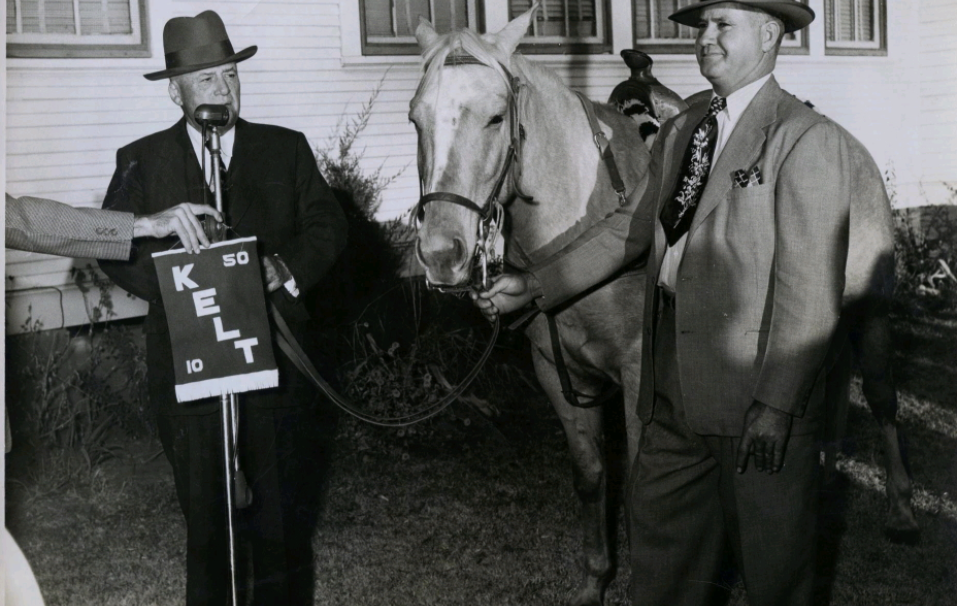By Andrew Fitzgerald, Education Intern, Sam Rayburn House State Historic Site
"No hour of life is wasted that is spent in the saddle." —Winston Churchill
Few items are more important for a cowboy than his saddle. A quality saddle immediately assures greater comfort for both horse and rider on long journeys; it has also been proven that a properly crafted and fitted saddle is healthier for a horse in the long term. A cowboy who truly loves his steed will only buy the best saddle for them.
Former House Speaker Sam “Mr. Sam” Rayburn, when not shaping the future of the country in Washington, D.C., would spend the days relaxing and riding on his farm in Bonham. He owned several horses. Oral histories in our collection from cousin Minnie McTeer and niece Martha Rayburn mention two, named Tijuana and Pansy.
He was also presented with a Palomino named Whistle Stop by the Electra Chamber of Commerce in 1950. Rayburn gave horses as gifts, a fact shared by his niece Martha in a 1980 interview. He was very “generous” with his nieces, she fondly recalled. Rayburn also raised and sold cattle and horses on his 121 acres and remained a man of the land for his entire life.
Evidence of this is still displayed in his bedroom at the Rayburn house. Visitors can see Stetson hats and cowboy boots worn by the Speaker himself, but what immediately draws attention is the ornate riding saddle that is mounted on a stand next to Mr. Sam’s bed in his upstairs bedroom.

The leather saddle was hand tooled and ornately decorated with flowers and star-embossed fastenings that give it a distinctively Texan look. It was valued in 1979 at about $700, or close to $3,000 when adjusted for inflation. The letters “SR” can be found engraved under the cantle at the back of the saddle, verifying it as the Speaker’s property. Rayburn apparently thought the saddle was so nice that he kept it as a room decoration and only rode it in parades. We know the saddle was a gift to Mr. Sam, but unfortunately, we have conflicting information about who gave him the saddle.
Like many of Rayburn’s most prized possessions, the saddle was a Texas product. It was manufactured by the Padgitt Brothers Leather Company based out of Dallas, TX. Student Winnie MacIver wrote about the Padgitt Brothers company in 1953 for The Junior Historian. MacIver stated that Jesse Padgitt (who was a Tennessee native like Sam Rayburn) had founded his company in the wake of the American Civil War (1861-1865) as he followed the expanding railroad business. His brother William would eventually give up his own Waco business to enter a partnership with Jesse, and the Padgitt Brothers were soon renowned as leaders in the Texas leather trade.
Business boomed during World War I (1914-18). Both the English and French militaries enlisted the Padgitt Brothers for their war efforts, but this partnership would prove dangerous. Several newspapers reported that on July 26, 1915, a bomb exploded under the bed of Padgitt Brothers foreman M.T. Moore and his son as they slept (the two were sharing a bed at the time). Jesse, then the president of the company, had received three anonymous telephone calls threatening a bombing at his home if war orders were not cancelled just before the Moore home exploded. Police officers found explosives underneath Jesse’s home, which they disarmed.

Both Moores survived, although the senior Moore was left with serious injuries. It is unclear whether the bomber was ever apprehended. The Albuquerque Morning Journal reported that Padgitt laid off 100 workers for their own safety following the attack, and the saddlery department was briefly closed. A brief history of Swiss Avenue in Dallas, where the Padgitts lived at one time, credited the attacks to supporters of Germany’s military efforts.
The saddle, like many other personal effects preserved at the Sam Rayburn House, offers a chance for visitors to learn more about an often-overlooked figure in American history. There are always fascinating stories hidden just beneath the surface, wherever you look. Learning about the detailed past is always richly rewarding.

